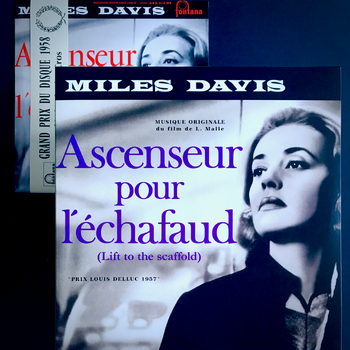MAGIC NOIR MILES
Author: Bruce Jenkins Date Posted:12 January 2024

The first feature film by esteemed French director Louis Malle is known by many names. Based on a 1956 novel by Noël Calef, in Europe it adopted the book title, Ascenseur pour l’Échafaud. In English this stylish 1958 film noir is known either as Elevator To The Gallows or Lift To The Scaffold. For American audiences the title was simplified to Frantic. Whichever name you encounter, there is a constant that makes it a special film: the superb musical score by Miles Davis.
Recorded in a Paris radio studio late one evening in December 1957, Miles was accompanied by the musicians he had been touring with. They were well acquainted with each other and brought a relaxed ensemble feel to the session. Drummer Kenny Clarke had been living in France for a year and was an obvious choice for many visiting American jazz musicians. The other three members of the quintet were French; tenor sax player Barney Wilen, respected be-bop pianist René Urtreger, and the hugely experienced and talented bass player Pierre Michelot (who played with everyone from Dexter Gordon and Bud Powell to Django Reinhardt). Michelot recalls the date well. "We arrived at the Poste Parisien around ten… had a drink together. Miles was very relaxed."
In fact, Davis had viewed a rough cut of the film some time earlier, invited to do so by Director Malle. He knew, according to Pierre Michelot, "exactly what he wanted and he also knew what he wanted from us." And what the director and trumpeter both wanted was a relaxed, improvised score that did not slavishly follow the on-screen action, rather offering a counterpoint to the images.
The result is a languid and astonishingly beautiful recording that would grace the collection of any jazz fan, particularly those who love Kind Of Blue.
Opening piece "Générique" is anything but generic. Miles leads from the front with a haunting melody delicately supported by Michelot’s bass and some quiet piano. "Ll’assissinat de Carala" is brooding, almost sinister; Miles’ capacity for excluding notes out is demonstrated superbly. In fact, an apt description of these ten pieces would be sparsely beautiful. Though things do hot up now and then. "Sur l’autoroute" ("On the Highway") is as fast as the title cue suggests. Wilen’s tenor sax and Davis’ trumpet trade rippling runs over a thrillingly frantic bass line by Michelot.
But most of the pieces are slower. In its original review, legendary jazz and blues magazine Down Beat observed:
"It is Miles one remembers from these tracks; he conveys the concentrated beauty and stark drama of, say, Billie Holiday. His sadness is devastating here, just as his lyricism is exquisite."
High praise indeed, and richly deserved.
Finally, a few notes on different versions. The original recording was released as an award-winning 10" disc though this format was already being rapidly replaced by the long-playing record. Fortunately the music has been reissued numerous times on both LP and CD. One version is called Jazz Track, and includes further sessions from around the same period.
A Wax Time In Color vinyl re-issue from 2018 reinstates the title Ascenseur pour l’Échafaud and includes three longer tracks as the second side. These are by the same sextet who had recently recorded Kind Of Blue and the results are exactly what one would expect: absolutely top shelf. For purists, the February 2024 Decca 12" re-issue of Ascenseur pour l’Échafaud will be the one they favour.
All in all, this soundtrack album is a most attractive package. Lovers of film will enjoy the classic noir movie while jazz fanatics will be frantic about getting hold of the music. It would be a crime not to.
© Bruce Jenkins—January 2024

